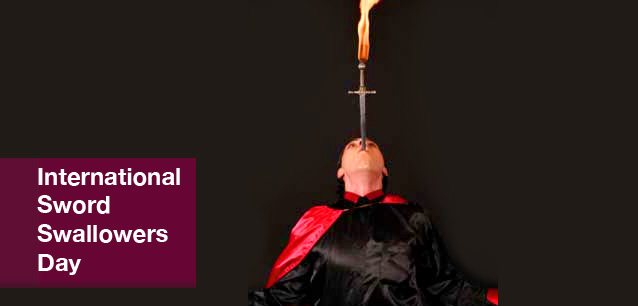 AD
AD
Today is: December 23
Scroll to explore events active on this date.
LEEP INK FEATURES

August? Absolutely!
In August, we live through the Dog Days of Summer. It's hot and often humid, and those who can leave for better climates do. Down south, winter is in full force. August is also known as "the ...

In The Heat of July: July 2025 Events
Is it hot enough (or cold enough if you're below the equator) for you yet? There is actually a day for that! Like every month, I pick a diverse collection of events you may or may not know about. This ...

May Blooms: Events in May 2025
Along with October, May is one of the most densely packed months of the year. It's before the summer humidity and the last whole month of the school year. The weather is warming in t...
About Sword Swallowers Day
Career
Ends: Feb 22, 2025
DESCRIPTION:
FOCUSING ON SWALLOWING DISORDERS
INTERNATIONAL SWORD SWALLOWERS DAY
Sponsored by the Sword Swallowers Association International (SSAI), President Dan Meyer noted the purpose of the day is to raise awareness of sword swallowers worldwide. It is co-sponsored by Ripley Entertainment and observed in conjunction with February's National Swallowing Disorders Month.WHAT IT IS
Under carnival lights in the 19th century, audiences looked on in awe as a performer calmly tilted his head back and slid a gleaming steel blade down his throat. The spectacle, known as sword swallowing, was both mesmerizing and terrifying, earning it a lasting place in the annals of extreme entertainment.BORN IN ANTIQUITY
The origins of sword swallowing date back more than 2,000 years, primarily to the Indian subcontinent, where it was practiced as a spiritual ritual. Ancient accounts and oral traditions suggest that religious mystics used the practice to demonstrate their supernatural control over the human body. Over centuries, the skill traveled through Asia to Europe, where it became woven into the tapestry of street performances, side shows, and fairs.
By the late Middle Ages, wandering minstrels and circus troupes introduced sword swallowing to Western audiences, capitalizing on its shock value. During the Victorian era, science and curiosity collided when doctors and medical researchers began to study the phenomenon, intrigued by the performers' ability to suppress reflexes that most people cannot voluntarily control.A CAREFULLY CULTIVATED SKILL
The secret to sword swallowing lies in meticulous training that involves suppressing the gag reflex and carefully aligning the mouth, pharynx, and esophagus. Practitioners start by learning to relax their throat muscles, often through exercises that gradually help them overcome the body's natural defenses.
"Sword swallowers train their muscles to the point where they can keep their throats open and allow a rigid object to pass safely," said Dr. Sanjay Rao, a gastroenterologist who has studied the performance art. "It's not magic—just extremely disciplined physiology."
When the performer inhales, they align the steel blade with the esophagus, bypassing the epiglottis, which normally closes to protect the airway. They maintain a straight posture and extend the neck to ensure no flexing or bending occurs once the blade enters. The dull edges of the sword and complete stillness on stage (no sudden movements or twists) are critical to prevent injury.DANGER AND ENDURANCE
Despite the controlled process, sword swallowing remains fraught with danger. Lacerations, perforated organs, and even life-threatening infections can occur. Historically, some performers found themselves used as medical curiosities, undergoing early forms of endoscopy and X-ray observation to teach scientists about the esophagus.
In modern times, the Sword Swallowers Association International (SSAI) tracks and recognizes practitioners who continue the centuries-old tradition. They acknowledge the artistry and the peril that come with each performance.BEYOND THE SHOCK FACTOR
Today, sword swallowing is a spectacle at festivals, variety shows, and special events—an enduring testament to human courage and physical control. Yet, for every crowd that gasps in wonder, there is a cautionary tale.
"The risk is always there, no matter how experienced you are," said SSAI performer Amy Saunders, who has practiced sword swallowing for nearly a decade. "We do this because it's a part of our heritage as entertainers and because it pushes the limits of what we think we're capable of."
Sword swallowing's longevity comes down to more than just showmanship. Its combination of mystique, history, and real peril gives it an enduring grip on popular culture. Whether it first captivated an ancient temple crowd or a modern-day audience, the spectacle continues to blur the line between spiritual discipline, scientific curiosity, and pure, edge-of-your-seat entertainment.
VIDEOS
SUPPORTING DOCUMENTS
Currently, this event does not have supporting documents.
ADDITIONAL IMAGES
Currently, this event does not have supporting images.
Where would you like to go now?
 AD
AD


/footer-logo.svg)
